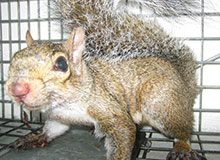Wildlife Trapping Professionals Thousand Oaks, California
Call us now at 805-601-8731 for professional wildlife removal services in Thousand Oaks, CA.

805-601-8731 - Call 24/7
We work 7 days a week - go ahead and call evenings and weekends!
Licensed & Insured
We carry liability insurance and all California licenses.
Professional Service
Treating both wildlife and customers with courtesy and respect.
We are a professional animal removal company headquartered in Thousand Oaks, and servicing all of Ventura County, CA. We solve problems with wild critters in the home and around the property. We handle animals such as squirrels, raccoons, skunks, rats, mice, opossums, and even snakes,
bats, and birds. We most commonly receive calls about scratching sounds in your attic, or digging in your lawn, or many other critter problems. We not only remove animals, but we provide a wide array of services, from animal damage
repairs, preventative home repairs, attic cleaning, and more. We are fully licensed and insured in California, and we answer our phones 24/7. Call us now at 805-601-8731 for a free price quote and to schedule a same-day or
next day appointment for animal removal.
Possessing the necessary wildlife apprenticeship skills and carrying the essential accreditation, we are proud to say that we have the most technically-skilled people not only in the local area but in the entire wildlife control industry. We, at our company, are committed to providing only the superior quality of service and results to our customers. By integrating the right amount of consideration and professionalism in all aspects of the operation, and by implementing a world-renowned management system, our customers can guarantee that they will enjoy the best possible results. We are embracing this system to promote continual improvement of everything related to the company.
About Our Company

Services We Offer
- Wildlife Trapping
- Prevention Repairs
- Attic Cleanup
Best service in Thousand Oaks
- Superior wildlife control from attic to yard, start to finish.
- Available 24/7 with weekend and same-day appointments
- Humane treatment of animals and professional service for you.
Client Testimonials
-
Thank you for coming to my home on a Sunday to get the snake on my porch - I almost had a heart attack before you showed up!
-
Thousand Oaks Pest Animal Trapping solved a problem with bats in our building, after two other California companies failed - and at a price lower than the others! Thank you!
-
My regular pest control company couldn't get rid of my rat problem - these guys cleaned them out in five days! I've been rat-free ever since!
Thousand Oaks Wildlife Trapper Tip of the Month:
About Moles Appearance, biology, Left cycle, habitat, diet, behaviorIntroduction
Moles possess a tiny body and are a mammal. A variety of about 20 Illinois moles are found all over the world. Some commonly found types of moles will be discussed below in general.
Biology
A few types of moles are known as:
- Western
- Eastern
- American Shrew
- Hairy Tailed
- Star Nosed
How they appear?
Moles have poor eyesight since they are hardly around 16-20 cms. There is always size difference between the males and females of the mole family. Male tend to be larger as compared to the females. The greater percentage being about 20% larger for males. Moreover, moles come with a thick layer of fur that has shades of black & grey around their body having a brilliant sense of smell.
Life Cycle
The birth of younger ones take around 4 to weeks with their mating time being from February to April. The numbers here also speak a lot as 4-6 moles are easily born in one shot. The babies only get to live with their moms for 5 to 6 weeks and then are left on their own until the lifespan of 5-6 years is complete or they become a victim of one of their predators.
Habitat of Moles
Moles find wet and dry places both comfortable to live in. Usually found within marshes, hayfields, woodlands and in human territory. However, you will find them making burrows in the yards to live.
Behavior
If we talk about Chicago Suburbs, they love to feed on insects, slugs & worms. Star nosed moles are bigger and require proper appetite so they would prefer fishes as they also live near water. The saliva of moles is poisonous with which they can get the food in their own way.
What kind of damage can Rabbits cause?
Canada Goose Prevention – How To Keep Canada Geese Away from Yard or Pond?
How to get rid of Coyotes? (Discuss prevention via fences, exclusion, trapping etc.)





